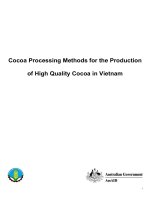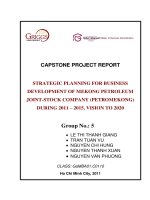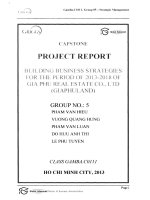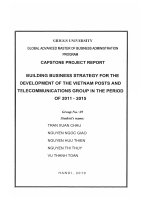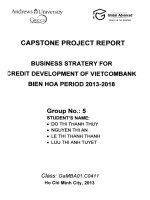Strategies for business development of TWG chain stores in vietnam
Bạn đang xem bản rút gọn của tài liệu. Xem và tải ngay bản đầy đủ của tài liệu tại đây (1.63 MB, 83 trang )
ĐẠI HỌC QUỐC GIA HÀ NỘI
KHOA QUẢN TRỊ VÀ KINH DOANH
---------------------
TRƯƠNG NHẬT HOÀNG
STRATEGIES FOR BUSINESS DEVELOPMENT
OF TWG CHAIN STORES IN VIETNAM
CHIẾN LƯỢC PHÁT TRIỂN KINH DOANH
CHUỖI CỬA HÀNG TWG TẠI VIỆT NAM
LUẬN VĂN THẠC SĨ QUẢN TRỊ KINH DOANH
HÀ NỘI - 2018
ĐẠI HỌC QUỐC GIA HÀ NỘI
KHOA QUẢN TRỊ VÀ KINH DOANH
---------------------
TRƯƠNG NHẬT HOÀNG
STRATEGIES FOR BUSINESS DEVELOPMENT
OF TWG CHAIN STORES IN VIETNAM
CHIẾN LƯỢC PHÁT TRIỂN KINH DOANH
CHUỖI CỬA HÀNG TWG TẠI VIỆT NAM
Chuyên ngành: Quản trị kinh doanh
Mã số: 60 34 01 02
LUẬN VĂN THẠC SĨ QUẢN TRỊ KINH DOANH
NGƯỜI HƯỚNG DẪN KHOA HỌC: TS. PHẠM VĂN HỒNG
Hà Nội - 2018
DECLARATION
The author confirms that the research outcome in the thesis is the
result of author’s independent work during study and research period and it is
not yet published in other’s research and article.
The other’s research result and documentation (extraction, table,
figure, formula,and other document) used in the thesis are cited properly and
the permission (if required) is given.
The author is responsible in front of the Thesis Assessment
Committee, Hanoi School of Business and Management, and the laws for
above-mentioned declaration.
ACKNOWLEDGEMENT
I would like to express my deep gratitude to the teachers of the Hanoi
school of Business and Management, Vietnam National University, especially
the teachers who imparted to me a lot of knowledge and helped me. Carry out
this essay.
I would like to express sincere gratitude to Dr. Pham Van Hong has spent a
lot of time, dedicated guidance, only told me during the course of the topic.
I sincerely thank family, friends and colleagues for encouraging and
supporting me in the process of study and research.
TABLE OF CONTENTS
LIST OF ACRONYMS..............................................................................................i
LIST OF TABLES.....................................................................................................ii
LIST OF FIGURES AND CHARTS ..................................................................... iii
INTRODUCTION .....................................................................................................1
1. Urgency of the topic......................................................................................... 1
2. Overview of the study ...................................................................................... 2
3. Research objectives and tasks ......................................................................... 5
3.1 Objectives .......................................................................................... 5
3.2 Tasks ................................................................................................. 5
4. Objects and scope of the study ....................................................................... 6
4.1 Objects of the study ........................................................................... 6
4.2 Scope of the study ............................................................................. 6
4. Methodology ..................................................................................................... 6
5. Organization of the thesis ................................................................................ 6
CHAPTER 1: RATIONALE OF BUSINESS STRATEGY OF ENTERPRISES7
1.1 Rationale of strategy ...................................................................................... 7
1.1.1 Definition ....................................................................................... 7
1.1.2 Role of strategy .............................................................................. 8
1.2 Building business development strategies of the enterprises.................... 8
1.2.1 Definition ....................................................................................... 8
1.2.2 Strategy building process .............................................................. 9
CHAPTER 2: ANALYZE BUSINESS ENVIRONMENT OF TWP IN
VIETNAM ...............................................................................................................24
2.1 Introduction about TWG ............................................................................. 24
2.2 Analyze external environment factors ....................................................... 24
2.2.1 Macro factors ............................................................................... 24
2.2.2 Sector factors ............................................................................... 31
2.2.3 Summary of EFE matrix evaluation ............................................ 34
2.3 Analyze internal environment factors of TWG Vietnam ........................ 36
2.3.1 Quality of human resources ......................................................... 36
2.3.2 Products ....................................................................................... 37
2.3.3 Financial capacity ....................................................................... 39
2.2.4 Market research ........................................................................... 39
2.2.5 Marketing activities ..................................................................... 41
2.2.6 Synthetize and evaluate IFE matrix ............................................. 43
2.4 Summarization of opportunities, challenges, strengths and weaknesses
in developing TWG tea stores in Vietnam. ..................................................... 44
2.4.1 Opportunities and challenges ...................................................... 44
CHAPTER 3: DEVELOP STRATEGIES FOR TWG CHAIN IN VIETNAM.48
3.1 The objectives for business development of TWG in the next time ...... 48
3.2 Analyze matrix and select strategies for developing chain of TWG
stores .................................................................................................................... 49
3.2.1 Develop strategies for developing chain of TWG stores using
SWOT matrix ................................................................................................... 49
3.2.2Select the optimal strategic plans through QSPM matrix ............ 53
3.2.3 Process of implementing the strategies ....................................... 66
3.3 Solutions to implement the selected strategies. ........................................ 67
3.3.1. Additional services with TWG tea .............................................. 67
3.3.2. Promote activities of marketing and market expansion ............. 68
3.3.3 Improve the quality of human resources ..................................... 69
3.3.4. Establish marketing department, promote market research ...... 70
CONCLUSION........................................................................................................71
REFERENCES ........................................................................................................73
LIST OF ACRONYMS
1
VNPost
Vietnam Post Corporation
2
VNPT
Vietnam Posts and Telecommunications Group
3
TCBC
Postal finance
4
TCT
Corporations
5
CBCNV
6
PTI
Officers and employees
Post Insurance Joint Stock Corporation
i
LIST OF TABLES
Table 1.1: External factor evaluation matrix (EFE matrix)...................................16
Table 1.2: Evaluation matrix of internal environment factors (EFE) ...................19
Table 1.3: SWOT mtrix model ...............................................................................20
Table 1.4: Summary table of QSPM matrix...........................................................22
Table 2.1: Some economic indexes of our country ...............................................25
Table 2.2: Policies of domestic tea support ............................................................27
Table 2.3: Customer survey result of TWG ...........................................................31
Table 2.4 Comparison of tea TWG with some competitors .................................32
Table 2.5: Summary of EFE matrix evaluation .....................................................34
Table 2.6: Human resources in TWG .....................................................................36
Table 2.7: Characteristics of TWG tea products ....................................................38
Table 2.8: Market research activity of TWG .........................................................40
Table 2.9: Marketing activities of TWG ................................................................41
Table 2.10: Synthetize and evaluate IFE matrix ....................................................43
Table 3.2 : QSPM matrix for group combination of S-O......................................54
Table 3.3: QSPM matrix for group combination of S-T .......................................57
Table 3.5: QSPM matrix for group combination of W-T .....................................63
ii
LIST OF FIGURES AND CHARTS
Picture1.1: M. Porter’s model of five competitive forces .....................................13
Figure 3.1 Process of implementing the strategies for developing the chain of
TWG tea stores till 2027..........................................................................................67
iii
INTRODUCTION
1. Urgency of the topic
The fact that Vietnam signed the Trans-Pacific Partnership (TPP)– which
willofficially come into effect in 2018 - has opened up many opportunities for
enterprises to invest and develop their business. Accordingly, as soon as the TPP
comes into effect, the export and import tax rate among TPP member countries
will be0%. This facilitates the expansion and investment of foreign enterprises in
Vietnam. As one of the members of TPP, Japan is currently the country with the
largest import-export volume to Vietnam. The number of Japanese enterprises in
Vietnam is increasing in quantity.
TWG Tea is one of the famous brands of Japan. TWG Tea currently
has 55 stores in 16 countries including Singapore, the United Kingdom,
Japan, and the UAE. In order to catch the opportunity from TPP, by the end of
2016, TWG officially opened a Salon and Boutiqueselling tea at B2 floor at
Takashimaya, Ho Chi Minh City, Vietnam with more than 800 kinds of
premium teas and exclusive processed teas. Defining Vietnam as a fast
growing and a potential market for premium tea consumption, TWG Tea
intends to develop its TWG chain stores in Vietnam in the near future.
However, the later entrance to the market than other strong competitors from
China, Thailand, Taiwan, etc and the habit of using domestic tea brands of
Vietnamese consumers will be a great challenge for TWG Tea when it wants
to develop business in Vietnam.
So, it can be seen that although TWG Tea’s products have more
competitive advantages than other competitors in terms of quality and
brandname, but with the difficulties and challenges mentioned above together
with new business market, it is necessary to build business strategies when
TWG wants to develop the TWG Tea chain stores in Vietnam in the coming
time. For those reasons, the author decided to select the topic "Strategies for
business development of TWG chain stores in Vietnam" as a master thesis.
1
2. Overview of the study
Johnson & Scholes (2000) conducted a study on "Exploring Corporate
Strategy: Test and Case". According to them, in an organization or an
enterprise, "Strategy is the orientation and determination of an organization’s
operation scope over a long term, where the organization must gain
advantages through the combination of resources in a challenging
environment to best meet the needs of the market and the needs of the agents
involved". In particular, in the study, the authors introduced three broad
strategies of competition including low cost, differentiation, and focus, which
turned strategy positioninginto a structured activity. The research focused on
evaluating strategies of competition without going into the details of strategies
for developing business of a product.
TOPICA Educational Organization (2012), in their lecture of
"Overview of strategy development of enterprises", says that the processof
building a general corporate strategy consists of 3 phases:Establishing
(planning)
strategies,deploying
(implementing)
strategies
and
evaluatingstrategies. (1) The stage of planningstrategies is understood as a
process of establishing vision and mission;conducting investigations to
identify opportunities, challenges, strengths and weaknesses of the
enterprise,building long-term goals and selectingtacticalplans to achieve
them. (2) The stage of implementing strategies is the stage of transforming
strategy contents into strategy actions. Deploying strategies involves
conducting necessary things to make the strategies done and achieve the goals
of the organization. (3) The stage of evaluating strategies consists of three
main activities: reconsidering factors which are the basis for the current
strategies, measuring achievements and performing corrective actions.
Frederick W. Gluck et al. (1980) in "Strategic Management for
Competitive Advantage" compared and described the process of strategy
2
development for an organization. The authors called the first stage of
development as elementary financial planning. At this stage, the primary
concern was addressing financial constraints through rigorous operation
monitoring, planning annual budget allocations, and paying attention to
operational and financial functions, etc. The purpose of setting up the
strategies was to mobilize all resources to build competitive advantages. The
planning of strategies answers the four basic questions: (i) Where are
enterprises/organizations? (ii) Where do theenterprises/organizations want to
go in the future? (iii) How to get there? (iv) How to measure the progress?
Le The Gioi (2012) carried out a study on "Introduction to strategy
development and mission declaration." The study compared the strategies in
military and economic fields. In military, strategies refer to the management
skillsof exploiting forces to crush the enemy and create a global dominance
system. The basic theoretical point of the strategies is that one party can crush
a competitor - even stronger and more crowded - if they can lead the game
and put their opponents in a situation which is favorable for their abilities. An
organization's strategies are similar to those in militarybecause they are
planned to achievethe agreement between the differentiating capacities and
the external competitive environment in which the organization participates
in. However, compared to military strategies, strategies in business are more
complicated. Unlike military conflicts, competition in business does not
always come up with a winning or losing result. The competition in the
industry sometimes creates opportunities to improve their strengths and skills
as competing seeds. The value of differentiating capacities that bring
competitive advantagesto the organization can be reduced over time due to
environmental changes.
Huynh Thi Thien Chung (2009) conducted a study on "Building
Decotex’s business strategies for curtains in Vietnamese market to 2015". In
3
the study, the author interviewed 200 customers at supermarkets in Ho Chi
Minh City with the questionnaire and conducted discussions with directors,
heads of departments and business managers to collect the necessary
information to explore the external and internal factors of the enterprise. By
using the SWOT matrix to develop feasible strategies and using the QSPM
matrix to select the optimal strategies, Huynh Thi Thien Chung proposed
solutions for deployingstrategies includingbuilding a table of business tasks,
maintaining and developing business advantages,building a new value line for
the blue ocean strategy.
Le Thai Son (2010) carried out a study on "Building strategies
forbusiness development of CaDaSa Joint Stock Company for Dalat ancient
villa resort to 2015". The study analyzedthe needs fortaking vacation
combining with conferences and the ability to meet the demand in Da Lat in
general and atDa Lat villa ancient resort in particular. In addtition to assessing
the business development potential of Dalat ancientvilla resort through
strategies,the study proposed business development strategies for this resort to
develop a new product for CADASA Joint Stock Company in the early stage
of business and create the foundation for future development. However, since
the study was conducted with the time from 2010 and earlier, the research
results did not havea highly practical value.
It can be seen that there have been many studies on strategies, strategy
management, and strategy development in our countries as well as abroad.
However, since TWG Tea is a new product in the market in general and in
Vietnamese market in particular, no research has been conductedonbuilding
strategies for business development of TWG chain stores. Therefore, based on
the theoretical basis of the published research, the author conductedthe study
“Strategies for business development of TWG chain stores in Vietnam. On the
basis of inheritance, the thesis would continue to clarify the following issues:
4
Firstly, continue to study the theoretical basis so that it can be flexibly
applied to the building of development strategy of TWG.
Secondly, analyze the macro environment and industry environment in
order to identify the opportunities and challenges for the development
strategies of TWG chain stores in the coming time.
Thirdly,analyze and evaluate the reality of TWG in all aspects:
business, human resources, finance, facilities, organizational structure, etc. in
order to point out strengths and weaknesses.
Fourthly,combine opportunities and challenges with strengths and
weaknesses to form strategies for business development of TWG chain stores.
Fifthly,declare the mission, vision, and development objectives of
TWG;propose to implement the strategies for business development TWG
chain stores in Vietnam in the coming time.
3.Research objectives andtasks
3.1 Objectives
The study aimed at building strategies for business development
ofTWG Tea chain stores in order to help TWG increase its market share in
Vietnam.
3.2 Tasks
Analyzing external environmental factors including macro environment
and industry environment to identify opportunities and challenges for the
development of TWG tea chain stores in Vietnam.
Finding out the strengths and weaknesses of TWG through theanalysis
of internal environment.
By analyzing the SWOT matrix,building strategies for business
development of TWG chain stores in Vietnam.
Usinginstruments and matrices to select the optimal strategies for TWG
Tea.
5
Implementing the strategies to help TWG Tea chain stores increase its
market share in Vietnamese market.
4. Objects and scope of the study
4.1 Objects of the study
Objects of the study were factors from internal and external business
environment which formed the basis for building the development strategies
of TWG chain stores.
4.2 Scope of the study
In terms of time: The data was collected since TWG opened its stores
in Vietnam.The end of 2015 to present
In terms of space: The study was conducted salon và boutique of TWG
is Takashimaya, Ho Cho Minh City.
4. Methodology
5. Organization of the thesis
6
CHAPTER 1: RATIONALE OF BUSINESS STRATEGY OF
ENTERPRISES
1.1 Rationale of strategy
1.1.1 Definition
There are many definitions of strategy. The difference among those
definitions is mainly due to the view of each author. In 1962, Chandler, one of
the initiators and theorists of strategic management, defined that strategy is
the identification of long-term objectives of the enterprises, the acceptance of
a series of actions as well as the allocation of needed resources to achieve
these objectives (According to Rudolf Grunig & Richard Kuhn, 2003).
In 1996, M.E. Porter defined strategy as the creation of a unique and
valuable position that includes different activities. The core of establishing a
strategic position is to choose activities that are different from those of
competitors (this difference may be different activities with competitors or
similar activities but different implementing methods)
Nguyen Huu Lam, Dinh Thai Hoang and Pham Xuan Lan (2007)
defined strategy as established plans or actions taken to achieve
organizational objectives. According to the authors, strategies are considered
as plans for the future, includin planned strategies and the taken actions.
However, whether those strategies are planned or implemented, they should
aim at achievement of organizations’ objectives.
Recently, Johnson and Schole have defined that strategy is the longterm direction and scope of an organization to gain advantages through its
resources in a changing environment in order to meet the demands of the
market and satisfy the expectations of the stakeholders (According to Truong
Dinh Chien, 2011)
7
Thus, there are many different definitions of strategy. From above
definitions, it is possible to summarize the characteristics of the strategy
as follows:
- Strategy is always oriented
- Strategy always focuses on managers or head of the company to
determine the most important issues of the company.
- Strategy always builds up the business lines basing on company's
traditional specialized business fields and strengths.
1.1.2 Role of strategy
Manufacturers who want to approach consumers need to overcome a
very big gap which is market. The market is rapidly changing, requiring
enterprises to be more energetic to approach the market and make effective
decisions.
- Strategy is the key tool of the enterprises and is the driving force for
the development of business plans of enterprises. Strategy plays a decisive
role and controls the coordination between the enterprises’ business activities
and the market, ensuring that the business activities of the enterprises can
follow market orientation by considering customers’ demands and expectation
as the most stable foundation for all business decisions.
- Strategy outlines the main features in business activities of the
enterprises. Basing on that, the enterprises shall carry out their production and
business activities to meet demands of the market.
1.2 Building business development strategies of the enterprises
1.2.1 Definition
Building business development strategies of enterprises is to use tools,
matrix to establish and choose business strategy suitable to the business
environment (internal and external environment) of the enterprises, from
which the enterprises can promote the strengths, restrain the weaknesses and
8
make use of every opportunity to deal with the challenges and risks to
develop business activities (Nguyen Van Binh, 2009).
1.2.2 Strategy building process
1.2.2.1 Identifying enterprises’ mission and objectives
Identifying strategic tasks and objectives is the first step in the process
of building business strategies of the enterprises. This activity is basis for
developing business strategies. In order to establish the mission and specific
objectives, management side of the enterprises can apply the 3C Principles
(Company Analysis, Customer Research and Competitor Understanding) to
establish the functions, duties and announce business policies and objectives
during operation and transaction process of the company.
The duties and missions of the enterprises must be developed and
sketched into a series of specific objectives. Objectives are achievement or
results that the enterprises want to achieve in the future. In other words,
objectives can be results from expectations of the enterprises.
1.2.2.2 Analysis of external environment
(1) Features of macro environment
Macro environment includes the factors outside enterprises’ orientation
and affecting operating environment and internal environment, creating
opportunities and threats to the enterprises (Nguyen Khoa Khoi and Dong Thi
Thanh Phuong, 2007).
Legal and political environment
- Politic
Politic is the first factor that the investors and enterprises’ managers
take care to forecast level of safety of the activities in the countries or areas
where the enterprises are having trading or investment activities. The factors
such as political policies, political stability or fluctuations in a country or
region are initial signals that help the enterprises identify the opportunities or
9
threats to make investment, production decisions in the market area within
national or international range.
- Law:
Creating a healthy or unhealthy business environment is entirely
dependent on the legal and economic aspects of state management. The
promulgation of a quality legal system is the first condition to ensure a fair
business environment and force the enterprises to be honest and responsible in
doing business. However, if the legal system is incomplete, it will have a
considerable impact on the business environment, causing difficulties in the
production and business activities of the enterprises.
- Government:
The government plays a very important role in regulating the economy
through its policies of economy, finance, monetary and spending programs. In
its relationships with the enterprises, the government both acts as a person
who controls, promotes, sponsors, regulates, prohibits, restricts and an
important customer of the enterprises (in the spending programs of the
government). Finally, government acts as a supplier providing the enterprises
with services such as macro information and other public services.
Economic environment
The economic environment is a very important factor that attracts the
attention of all executives. The impact of economic environment factors is
more direct and dynamic than other factors. The evolution of the economic
environment always contains different opportunities and threats for the
enterprises of different industries and has potential impacts on the strategies
of the enterprises. There are many economic environment factors but the
following factors have a great impact on business activities of the enterprises:
- Growth rate of the economy
- Interest rates and trends in interest rates of the economy
10
- Monetary policy and exchange rate
- Inflationary
- Tax system and tax rates
Socio-cultural environment
Socio-cultural environment includes norms and values which are
accepted and respected by a particular society or culture. The change of sociocultural factors is a partly consequence of the long-term impact of other
macro factors. Therefore, socio-cultural factors often occur more slowly than
other factors. Impact of socio-cultural factors is often more long-term and
subtle than others. Even, sometimes it is difficult to identify it. The executives
should pay attention to this trait of socio-cultural factors. The dimensions
establishing the socio-cultural environment have strong influences on
business activities such as ethical, aesthetic, lifestyle and occupational
attitudes; traditional customs; Social concerns and priorities; Level of
awareness and general education of the society ...
In addition, the population, also known as the demographic
environment, is also a very important factor influencing other factors of the
macro environment, especially social and economic factors. Changes in the
population environment will directly affect the change of the socio-economic
environment and affect the business strategy of the enterprises. The
demographic information provides important data for the executives in
building product planning, market strategies as well as marketing, distribution
and advertising strategies. Areas of concern for the population include: Total
population of the society, population growth rate; structure and trend of
population changes in age, sex, occupation, and income distribution; life
expectancy and natural birth rate; trends in population movement among the
regions, etc…
Natural environment
11
It can be said that natural condition is always an important factor in
human life (especially the elements of the ecological environment). On the
other hand, it is also a very important input factor of many economic sectors
such as agriculture, mining, tourism, transportation. However, in recent
decades, humanity has witnessed severe degradation of natural conditions,
particularly: Increased environmental pollution; the depletion and scarcity of
resources and energy; imbalances in ecological environment ... The strategic
executives need to have a flair for the threats and opportunities associated
with four trends in the natural environment, namely: (1) lack of resources; (2)
increasing energy costs; (3) Increased pollution levels
Technology environment
This is one of the very dynamic factors containing many opportunities
and threats to the enterprises. The pressures and threats from the technological
environment can be:
- The emergence of new technologies has led to the appearance and
competitive advantage of alternative products, threatening traditional products
of the existing industry.
- The explosion of new technology makes existing technology obsolete
and creates the pressure for enterprises to innovate to enhance their
competitiveness.
- The introduction of new technologies has created good conditions for
new manufacturers and increased the threats to existing enterprises in the
industry.
- The explosion of new technology has curtailed technology circle. This
raises pressure to shorten the depreciation period.
Beside above threats, the technological environment also creates many
opportunities for the enterprises, particularly as follows:
12
- New technology can facilitate the production of cheaper products with
higher quality, making products more competitive. Normally, the enterprises
coming later often have more advantages to make us of this opportunity than
the existing ones in the industry.
- The introduction of new technology can make the products more
functional and thereby create new markets for the company's products and
services.
(2) The factors of the industry environment
The industry environment (the operating environment) is the most
complex environment and also mostly affects the competition factors.
Michael Porter has introduced the concept of open competition. According to
that, competition in an industry depends on five forces: potential competitors,
alternative products, suppliers, customers, and current competitors in the
industry. The first four forces are considered as external forces and the
competition among competitors in the industry is considered as the fiercest
competition (according to Ngo Kim Thanh, 2011).
Picture1.1: M. Porter’s model of five competitive forces
Source:
Associate
Professor.Dr.
Development Textbook, 2011
13
Ngo
Kim
Thanh,
Strategy
These five competitive forces connect with each other to identify
competitive intensity and industry profit level. The strongest force shall
become key factor according to strategy development opinion.
Potential competitors
Adhering to the market of new enterprises directly reduces competitive
scale due to increase in manufacturing capacity and volume in the industry.
The appearance of new competitors might lead to a great shock for current
enterprises since the new comers often have lots of basis for making decisions
and their strategies are often unforeseen.
To beat the potential competitors, the enterprises often implement
strategies to distinguish products, improve quality, add new features to the
products and continuously innovate to make their products outstanding in the
market or try to reduce manufacturing expenses.
Pressure from the suppliers
As a supplier of the production input factors, power of the suppliers is
expressed through pressure of material price. The following characteristics of
the suppliers have big influences on business strategies of the enterprises in
the industry:
- Number of the suppliers: shows whether capacity of providing
material and selecting suppliers of the enterprises is high or not. Many
suppliers create the competition in the material market, helping to reduce
input expenses for the manufacturers.
- Exclusivity of the suppliers: creates good condition for them to force
price of the manufactures, causing difficulties in price competition.
- Relation between the suppliers and the manufactures: When the
supplier is also a manufacturer doing business in the same organization with
the manufacturer, the internal connection is maximum promoted. This helps
to create good condition for the manufacturers to compete in price.
14
To reduce bad influences from the suppliers, the enterprises should
have good relationship with the suppliers or purchase from different sources.
Among those sources, the enterprise should choose a main supplier and at the
same time look for alternative material, store reasonable material.
Pressure from the buyers
The buyers compete with other competitors in the industry by forcing the
suppliers to reduce price, negotiating to be provided with better products with
more competitive price and at the same time making the competitors compete
against each other. These waste the profit of the industry in general and the
enterprises in particular. Power of each group of customer of the enterprise
depends on a series of characteristics about market situation of the group and the
importance of the products that the customers purchased from the enterprises.
Customers can create great pressure if they have following conditions:
- A group of connected customers or a customer buying a greater
volume of products than the sold products of the seller
- Products of the enterprise do not have great difference and can be
replaced by products of other enterprises. The buyer can surely find new
supplier and make this enterprise compete with another.
Alternative products
The appearance of alternative products is an indispensable outcome in
order to meet the changes of market demands following the trend of more
diversified products with higher quality. This also leads to reduction in the
competition ability of the current products to be replaced by the new ones.
The alternative products often have higher competition ability since
they are produced under more advanced production line. Despite bearing the
opposition of the current products, the alternative products have more
advantages thus gradually narrow market of the current products (especially
the products being blocked by the social market demand). That the alternative
15
products develop well will reduce competition ability of the current products.
Solution for these enterprises is to direct to new products or the customers
seeking for new utility.
Current competitors in the industry
Competition among the existing enterprises in the industry is one of the
factors expressing nature of this environment. There are always various
enterprises in one industry but there are only some enterprises who play role
as the key competitors having ability of dominating the market.
Therefore, mission of each enterprise is to seek for information, exactly
analyze capacity of the competitors in the industry especially main competitors to
build up suitable competitive strategy with the general environment.
(3) Summarize results of external business environment analysis
According to results of external business environment analysis, it is
needed to evaluate and collect environment data to identify:
- Opportunities at the present and might appear in the future
- Risks, challenges, disadvantages at the present and might appear in
the future
Table 1.1: External factor evaluation matrix (EFE matrix)
External
Importance of the
environment
factors to the
factors
industry
(1)
(2)
Importance of the
factors to the enterprise
Scoring
(4)
(3)
1
2
....
Total
=1
Source: Nguyen Thi Lien Diep, 2006
16
